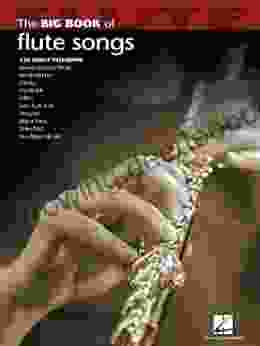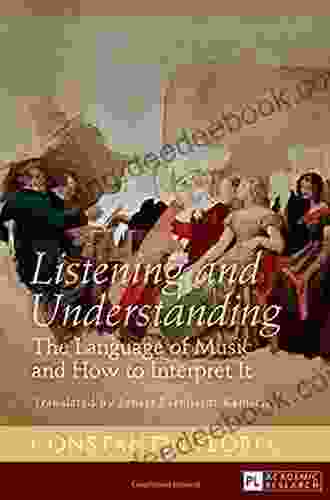The Language of Music and How to Interpret It: A Detailed Guide by Ernest Bernhardt

Music, an art form that transcends words, speaks a universal language that has the power to evoke emotions, paint vivid pictures, and convey profound messages. Understanding the language of music allows us to fully appreciate its beauty and meaning.
In his seminal work, "The Language of Music," Ernest Bernhardt, a renowned music theorist and educator, provides a comprehensive guide to interpreting music. Drawing upon his vast knowledge and experience, Bernhardt unravels the intricate elements of music and demonstrates how they work together to create musical expression.
5 out of 5
| Language | : | English |
| File size | : | 7054 KB |
| Text-to-Speech | : | Enabled |
| Screen Reader | : | Supported |
| Enhanced typesetting | : | Enabled |
| Word Wise | : | Enabled |
| Print length | : | 249 pages |
The Elements of Music
Bernhardt identifies four fundamental elements of music that form the foundation of musical interpretation:
- Melody: The succession of single notes that creates a recognizable and memorable tune.
- Harmony: The combination of multiple notes played simultaneously, creating a rich and layered sound.
- Rhythm: The pattern of beats and accents that gives music its pulse and sense of movement.
li>Dynamics: The variation in volume and intensity of sound, adding depth and expressiveness to music.
Interpreting Melody
Melody is the primary carrier of a musical message. To interpret melody, Bernhardt suggests paying attention to the following aspects:
- Contour: The shape and direction of the melody, indicating its emotional character.
- Range: The distance between the highest and lowest notes, influencing the melody's impact.
- Motifs: Recurring melodic patterns that create unity and coherence.
- Phrasing: The grouping of notes into meaningful units, shaping the melody's structure.
Understanding Harmony
Harmony provides the foundation and support for melody. Bernhardt emphasizes the importance of recognizing:
- Chord structure: The combination of notes that make up a chord, determining its sound and function.
- Chord progressions: The sequence of chords that creates harmonic movement, guiding the melody and shaping the overall tonality.
- Cadences: Musical punctuation marks that provide a sense of closure or direction, resolving or suspending the harmonic tension.
- Modulation: The shift from one key to another, adding variety and contrast to the music.
Appreciating Rhythm
Rhythm is the backbone of music, giving it a sense of motion and organization. Bernhardt advises listeners to focus on:
- Beat: The regular pulse that provides the underlying framework.
- Meter: The pattern of strong and weak beats that creates rhythmic groupings.
- Syncopation: The placement of accents on unexpected beats, adding interest and energy.
- Polyrhythm: The simultaneous use of multiple rhythmic patterns, creating complex and dynamic rhythms.
Dynamics: The Language of Expression
Dynamics, the variation in volume and intensity of sound, add depth and expressiveness to music. Bernhardt suggests listening for:
- Crescendo: A gradual increase in volume, creating a sense of anticipation or excitement.
- Decrescendo: A gradual decrease in volume, adding a sense of relaxation or resolution.
- Forte: A loud dynamic level, conveying power, passion, or intensity.
- Piano: A soft dynamic level, expressing tenderness, intimacy, or mystery.
Interpreting music requires a keen ear, an open mind, and a willingness to engage with the emotional and intellectual content of the music. By understanding the language of music and applying the principles outlined by Ernest Bernhardt, we can unlock the hidden depths of musical expression and experience the transformative power of this universal art form.
As Bernhardt eloquently stated, "Music is not merely a succession of sounds; it is a language with its own grammar, syntax, and vocabulary. Once we learn to interpret this language, the whole world of music opens up to us."
5 out of 5
| Language | : | English |
| File size | : | 7054 KB |
| Text-to-Speech | : | Enabled |
| Screen Reader | : | Supported |
| Enhanced typesetting | : | Enabled |
| Word Wise | : | Enabled |
| Print length | : | 249 pages |
Do you want to contribute by writing guest posts on this blog?
Please contact us and send us a resume of previous articles that you have written.
 Novel
Novel Page
Page Chapter
Chapter Text
Text Reader
Reader Paperback
Paperback Magazine
Magazine Paragraph
Paragraph Shelf
Shelf Bibliography
Bibliography Foreword
Foreword Preface
Preface Synopsis
Synopsis Annotation
Annotation Manuscript
Manuscript Scroll
Scroll Tome
Tome Bestseller
Bestseller Library card
Library card Biography
Biography Autobiography
Autobiography Memoir
Memoir Reference
Reference Character
Character Librarian
Librarian Borrowing
Borrowing Stacks
Stacks Archives
Archives Periodicals
Periodicals Research
Research Academic
Academic Journals
Journals Reading Room
Reading Room Special Collections
Special Collections Interlibrary
Interlibrary Literacy
Literacy Storytelling
Storytelling Reading List
Reading List Theory
Theory Textbooks
Textbooks Rajeev Motwani
Rajeev Motwani G Scholten
G Scholten Kandace Blevin
Kandace Blevin D J Taylor
D J Taylor Bruno De Stefano
Bruno De Stefano Aefa Mulholland
Aefa Mulholland Molly Lacroix
Molly Lacroix Lucy D Briand
Lucy D Briand Yuichi Handa
Yuichi Handa Christopher P Nichols
Christopher P Nichols Deb Baker
Deb Baker Thony Loui
Thony Loui Daniel O Klier
Daniel O Klier Jeff Anderson
Jeff Anderson Rob Horner
Rob Horner Hannah Beckerman
Hannah Beckerman Diane Trull
Diane Trull Brian Cerney
Brian Cerney Jane Keefer
Jane Keefer Matchbox Twenty
Matchbox Twenty
Light bulbAdvertise smarter! Our strategic ad space ensures maximum exposure. Reserve your spot today!
 Brennan BlairFollow ·9.4k
Brennan BlairFollow ·9.4k Andres CarterFollow ·13.8k
Andres CarterFollow ·13.8k D'Angelo CarterFollow ·17.7k
D'Angelo CarterFollow ·17.7k George R.R. MartinFollow ·12.8k
George R.R. MartinFollow ·12.8k Carter HayesFollow ·9.8k
Carter HayesFollow ·9.8k Ignacio HayesFollow ·10k
Ignacio HayesFollow ·10k Martin CoxFollow ·19.5k
Martin CoxFollow ·19.5k Damon HayesFollow ·11.5k
Damon HayesFollow ·11.5k

 Darius Cox
Darius CoxThe Gathering Pacific Storm: An Epic Struggle Between...
The Gathering...

 Hugo Cox
Hugo CoxHow CIA-Contra Gangs and NGOs Manufacture, Mislabel, and...
In the annals of covert operations, the CIA's...

 Finn Cox
Finn CoxDr. Brandt's Billionaires Club Series: The Ultimate...
A Journey into the Pinnacle of...

 Isaac Asimov
Isaac AsimovCurrent Affairs Daily Digest 20180730 30th July 2024
National ...

 Felix Carter
Felix CarterBroadway Celebrates The Big Apple Over 100 Years Of Show...
Broadway Celebrates the Big Apple: Over 100...

 Beau Carter
Beau CarterThe Big Book of Flute Solos: A Comprehensive Collection...
If you're a flute player,...
5 out of 5
| Language | : | English |
| File size | : | 7054 KB |
| Text-to-Speech | : | Enabled |
| Screen Reader | : | Supported |
| Enhanced typesetting | : | Enabled |
| Word Wise | : | Enabled |
| Print length | : | 249 pages |











